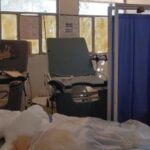LONDON — Lines at neighboring borders and protests are just some of the scenes in Russia following President Vladimir Putin’s call for partial military mobilization.
Last week, Putin ordered up to 300,000 Russians to serve in the invasion of Ukraine that began in February. Since then, thousands of citizens have fled the country to bordering nations, including Georgia and Mongolia.
A satellite image of the Russia-Georgia border taken on Tuesday shows a multitude of cars and people waiting at the crossing. According to Russian state news outlet Tass, more than 5,000 cars had created the traffic jam, which was up to 10 miles long.
The announcement also sparked a rise in the search for flights leaving Russia, sending prices soaring. Flights to destinations such as Turkey, Georgia and Armenia sold out.
Elsewhere, antiwar protesters clashed with police on a highway in Dagestan — one of Russia’s poorest regions. The demonstrators, mostly women, were chanting “No to war” as officers fired warning shots into the crowd in an attempt to disperse them. It is unknown whether anyone was injured.
In the town of Ust-Ilimsk in Siberia, a draft officer was shot by a man angered by his friend’s conscription, the Guardian reported. A video appears to show the officer being shot at close range. The governor of the region said on Telegram that the officer was in critical condition and that the gunman would “absolutely be punished.”
“Partial mobilization affects everybody,” Michael Kofman, head of Russian studies at the CNA think tank in Washington, D.C., told the Associated Press. “And everybody in Russia understands … that they could be the next wave, and this is only the first wave.”
Ukrainian President Volodymyr Zelensky called on Russians not to submit to the “criminal mobilization” and to “at least try to protect their own lives.”




